Genre: Fighting Developer: Sega Enterprises Publisher: Sega Enterprises Players: 1-2 Released: 1994
Street Fighter II was a game that revolutionized the fighting genre. After its gigantic success, there were dozens of companies trying to capitalize on this upcoming new sub-genre, the head-to-head fighter. The arcades were swarmed with Street Fighter II knock-offs (including the dozens of variations of Street Fighter II itself), most of which didn’t perform too well or didn’t leave a lasting impression. Among those companies, however, was a certain familiar three-letter-brand that managed to distinguish itself with quality titles and truly rode the wave of popularity following the new versus-fighter-phenomenon: SNK! It produced not just one but several series of high-quality fighting games and tried to distinguish its games from the other concurrent fighters by adding new style and flavor to the genre – well, style mostly. After the first installation of Garōu Densetsu (better known to Westerners under the moniker Fatal Fury), SNK didn’t even take a year in starting a second brand of fighting games known as Art of Fighting.
Ah, Art of Fighting! An almost poetic name for a head-to-head beat-’em-up game… and a suitable one to boot. It conveys form and style of the martial arts, not only strength and speed but also grace, fluidity of motion, and the energy of movement. Yes, this game was meant to be more than just two street fighting punks beating up each other, and the arcade game showed that. It also introduced several new elements into the genre that would later be a typical feature off SNK fighters. Yes, Art of Fighting was fun to play, the controls were firm, and the elements and effects truly were able to draw a crowd and set the SNK games apart from the mass of similar titles of the same kind. Needless to say, such arcade pleasers were ideal candidates for home console releases. Following its predecessor Fatal Fury, Art of Fighting was ported to the Genesis as well, adapted and reprogrammed for the Genesis by none other company than Sega itself!
Sounds promising, no? Of course, usually when an arcade game gets ported to 16-bit home consoles, cuts and tweaks generally have to be made. What then, when an IP developed by one of the greatest fighting game companies gets ported to the then-top of the line home console by none other than the console’s developer itself? What could go wrong? Well, a number of things, as a matter of fact.
First of all, the zoom effects, one of the visually most distinguishing aspects of the game, were tossed out entirely. While this isn’t particularly surprising considering the Genesis’ lack of proper zooming ability, it does force the game to stand on its own graphical abilities. However, those aren’t that impressive either. The stages look static and the backgrounds (including spectators) are reduced to still images devoid of life, aside maybe for two-frames of animation of a light flickering or something similar. The character sprites still move pretty decently, though their fluidity has taken quite a hit as well. This is notable especially when a character drops to the ground after a particularly hard hit; the game slows down noticeably. That Sega wasn’t able to get this game running smooth on its own console is rather annoying.
The control scheme of this port is messed up. Since one button has to be reserved for the taunt action, owners of three-button controllers are left with one button for punch or kick each; a hard variant can only be pulled off by pressing both buttons simultaneously. Owners of a six-button pad are slightly better off, but the options are baffling: Now, buttons X to Z all serve for taunt, A & B are for punches respectively kicks, and C stands for the hard attack. Granted, the original arcade only had four buttons to work with, but why do we get three buttons just for taunting? Why not two for weak and hard punches, and two for weak and hard kicks? Plus, later enemies are able to regenerate their spirit gauge far too quickly, so taunting your enemy is pretty useless outside of the two-player mode. Apropos: If you accidentally enter two-player mode with only one controller connected, it’s impossible to leave! Unlike other games, the second player isn’t chosen automatically if no character is chosen over time, and no option is given to return to the main screen. Thus, the only way to leave this screen is by resetting the console. Apart from that, the stage for a two-player match is chosen at the start menu, before you even enter two-player mode to begin with. Whoever thought that would be a good idea is beyond me.
In single-player mode you can try your luck on one of the mini games between certain stages. These serve a purpose other than simply upping your high score: After passing one of those your character gains harder attacks, a greater spirit gauge for special moves, or the ability to pull off the Super Death Blow. If you play this game you should try getting the Super Attack as soon as possible. Otherwise you might start the game right over again because the difficulty, though technically adjustable, is insane! The AI-controlled enemies often shower you in special attacks, so if you weren’t able to upgrade your character by passing the mini games, you’re royally screwed. Things are not being helped by the fact that the options only allow two difficulty settings, normal and hard, and even at normal only the more experienced gamers will be able to advance into the later stages. I guess the difficulty settings would have been reflected better if the game took the terms used in Doom. Normal would then be named “Ultra-Violent,” and hard would be the “Nightmare” setting.
The biggest problem with this port is that the style is completely gone. It doesn’t play as smooth as other games in the same genre; even the SNK-fighter released the year before on the Genesis, Fatal Fury, controlled tighter and had a better flow of gameplay than this. The inclusion of a broken options menu doesn’t help the game either. Pretty much the only original thing that’s left in this port (besides the spirit gauge) is the story line, and at this point, it works more to the game’s disadvantage. If you play single player mode, you can only choose one out of two characters – Ryo Sakazaki, and Robert Garcia, who both play virtually the same! The cut scenes only replace a few lines of dialog (and the fact that Ryo rides a motorbike while Robert drives a sports car), and the linear progression of the storyline means that you’ll always fight the same opponents in the same fixed order! This really drives the replay value down, especially since the story in itself isn’t that interesting to start with (Ryo is looking for his kidnapped sister and his best friend and rival Robert assists him). As for the ending… well, I won’t spoil it for you, but I have to say: even though I don’t expect a deep narrative of a fighting game (or, to be honest, any narrative at all), if a game tries to tell a story I’d like to see some sort of conclusion, even if it ends in a cliffhanger.
Overall, this port is a disappointment. It isn’t polished, it controls weakly, and it comes off as pretty mediocre, especially when compared to other SNK games on the Genesis like Samurai Shodown or even the earlier first installment of Fatal Fury, which at least had three characters to choose from in single-player mode that even handled differently. If you want to get a taste of some decent SNK fighting action, try those instead, but avoid Art of Fighting. Sega pretty much dropped the ball and screwed up this port. I myself might not be much of an artist or particularly good at fighting games, but I know what I like, and this one I don’t.
SCORE: 5 out of 10

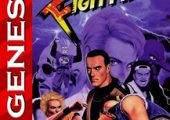
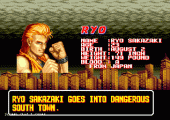
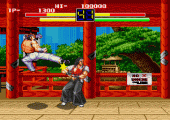
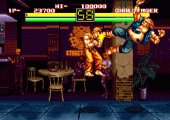
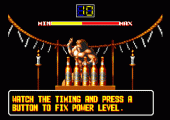
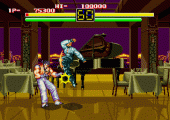
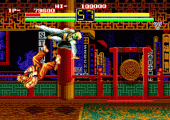
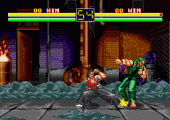
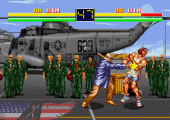
This game is an interesting case, since in most obvious respects it compares poorly to the SNES port, let alone the Neo Geo original. The character voice samples sound dreadful, the distinctive scaling is gone, and the difficulty system is messed up. And there are a bunch of obnoxious changes to the gameplay, most of which make the game more frustrating, like the limited continues — or try getting the Haoh Shoukou Ken on Hard.
And yet in some ways, I think it’s the best version of the game I’ve played. First, while the controls are less faithful to the arcade, it’s dramatically easier to pull off special moves. In the arcade and on the SNES, uppercuts are maddeningly inconsistent; on the Genesis, they work almost every time. (And yes, the Desperation Attacks ARE present on the Genesis; they’re just undocumented in the manual, and use different input sequences.)
The other thing is that the AI, while cheap and frustrating in many ways, at least offers a reasonable challenge. The SNES version seems good at first, but there’s a gaping hole in the AI that makes the game super-easy to beat once you find it. The Mega Drive version, released only in Japan, is far too easy. So that leaves the Genesis version.
Having said that I haven’t tried the PC Engine port, which has been widely acclaimed. Still I think this Genesis port, while deeply flawed, is better than its reputation. The SNES version looks great and has lots of bells and whistles, but if you can use a simple pattern to defeat almost every enemy, what’s the use?